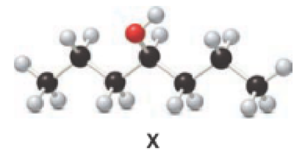
Concept explainers
a.
Interpretation:
The product obtained when the below compound reacts with H2SO4 reagent has to be determined.

Concept introduction:
Dehydration of alcohol:
When alcohol reacts with
b.
Interpretation:
The product obtained when the below compound reacts with K2Cr2O7 reagent has to be determined.

Concept introduction:
Oxidation of alcohol:
During oxidation of alcohol, the number of
Want to see the full answer?
Check out a sample textbook solution
Chapter 12 Solutions
Principles of General, Organic, Biological Chemistry
- Draw the product formed when (CH3)2CHOH is treated with each reagent (d, e and f)arrow_forwardWhat product is formed when each compound is treated first with LDA in THF solution at low temperature, followed by CH3CH2I ?arrow_forwardDraw the product formed when (CH3)2CHOH is treated with each reagent (a, b and c)arrow_forward
- Draw the organic product(s) formed when CH3CH2CH2OH is treated withfollowing reagent : [1] TsCl, pyridine; [2] NaSHarrow_forwarda.Label the four stereogenic centers in sorbitol as R or S. b.How are sorbitol and A related? c. How are sorbitol and B related?arrow_forward3-Fucosyllactose is another HMO found in breast milk. (a) Locate any acetal and hemiacetal. (b) What products are formed when 3-fucosyllactose is hydrolyzed in aqueous acid?arrow_forward
- Draw the products formed (including stereoisomers) when attached compound is reduced with NaBH4 in CH3OH.arrow_forwardWhat product is formed when acetic acid is treated with each reagent: (a) CH3NH2; (b) CH3NH2, then heat; (c) CH3NH2 + DCC?arrow_forwardDraw all constitutional isomers formed when X is treated with NBS + hv.arrow_forward
- a. Draw a three-dimensional structure for the following steroid. b. What is the structure of the single stereoisomer formed by reduction of this ketone wrth H2, Pd-C? Explain why only one stereoisomer is formed.arrow_forwardDraw the product(s) formed when A is treated with each reagent.a. NaBH4, CH3OH b. LiAlH4, then H2O c. Ag2O, NH4OH d. CrO3, H2SO4, H2O e. PCCarrow_forwardDraw the product formed when (CH3CH2CH2CH2)2CuLi is treated withattached compound. In some cases, no reaction occurs.arrow_forward
 ChemistryChemistryISBN:9781305957404Author:Steven S. Zumdahl, Susan A. Zumdahl, Donald J. DeCostePublisher:Cengage Learning
ChemistryChemistryISBN:9781305957404Author:Steven S. Zumdahl, Susan A. Zumdahl, Donald J. DeCostePublisher:Cengage Learning ChemistryChemistryISBN:9781259911156Author:Raymond Chang Dr., Jason Overby ProfessorPublisher:McGraw-Hill Education
ChemistryChemistryISBN:9781259911156Author:Raymond Chang Dr., Jason Overby ProfessorPublisher:McGraw-Hill Education Principles of Instrumental AnalysisChemistryISBN:9781305577213Author:Douglas A. Skoog, F. James Holler, Stanley R. CrouchPublisher:Cengage Learning
Principles of Instrumental AnalysisChemistryISBN:9781305577213Author:Douglas A. Skoog, F. James Holler, Stanley R. CrouchPublisher:Cengage Learning Organic ChemistryChemistryISBN:9780078021558Author:Janice Gorzynski Smith Dr.Publisher:McGraw-Hill Education
Organic ChemistryChemistryISBN:9780078021558Author:Janice Gorzynski Smith Dr.Publisher:McGraw-Hill Education Chemistry: Principles and ReactionsChemistryISBN:9781305079373Author:William L. Masterton, Cecile N. HurleyPublisher:Cengage Learning
Chemistry: Principles and ReactionsChemistryISBN:9781305079373Author:William L. Masterton, Cecile N. HurleyPublisher:Cengage Learning Elementary Principles of Chemical Processes, Bind...ChemistryISBN:9781118431221Author:Richard M. Felder, Ronald W. Rousseau, Lisa G. BullardPublisher:WILEY
Elementary Principles of Chemical Processes, Bind...ChemistryISBN:9781118431221Author:Richard M. Felder, Ronald W. Rousseau, Lisa G. BullardPublisher:WILEY





